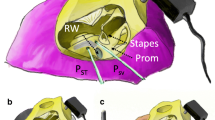Abstract
A new tubal transducer (NC-3) for measuring cochlear microphonics (CM) in extratympanic electrocochleography (ECochG) was developed by improving the common hearing aid earphone. Using a human forearm as a dummy ear, the artifact contamination generated from the NC-3 tubal transducer was tested and the possibility of measuring the CM at a non-shielded bedside was studied. An HN-5 electrode was fixed to a subject's forearm, and a sound stimulus of 90 dBnHL was delivered through the tube of the NC-3. When the earphone of the transducer was placed at a right-angle to the electrode on either a vertical or horizontal plane and the electrode was placed in direct contact with the tip of the tube, contamination from electromagnetic induction and CM-like mechanical vibration were prevented. Using the HN-5 electrode and NC-3, extratympanic ECochG-CM was recorded from normal-hearing subjects in both a shielded sound-proof room and a non-shielded ordinary, quiet room. No differences were found between CMs measured in the two rooms. These results suggest that the NC-3 overcomes the shortcomings of a loudspeaker system and allows CM to be recorded accurately at non-shielded bedsides.
Similar content being viewed by others
References
Chan L, Xluwu C, Li X (1992) Cochlear microhponics and recruitment. Acta Otolaryngol (Stockh) 112: 213–220
Eggermont JJ, Odenthal DW, Schmidt PH, Spoor A (1974) Electrocochleography. Basic principles and clinical application. Acta Otolaryngol (Stockh) [Suppl] 316: 17–24
Elbering C (1977) Some aspects of electrocochleography (ECoG). Fadl, Copenhagen, pp 489–495
Gibson WPR (1978) Essentials of clinical electric response audiometry. Churchill Livingstone, Edinburgh, pp 59–106
Hoke M (1976) Cochlear microphonics in man and its probable importance in objective audiometry. In: Ruben RJ, Elbering C, Salomon G (eds) Electrocochleography. University Park Press, Baltimore, pp 41–54
Nishida H (1981) Clinical application of electrocochleography. Pract Otol (Kyoto) 74: 134–138
Nishida H, Okada M, Tanaka Y (1993) Delayed responses in ECoG. In: Höhman D (ed) ECoG, OAE and introaperative monitoring. Kugler, Amsterdam, pp 41–44
Nishida H, Tanaka Y, Okada M, Inoue Y (1995) Evoked otoacoustic emission and electrocochleography in a patient with multiple sclerosis. Ann Otol Rhinol Laryngol 104: 456–462
Nishida N, Noguchi Y, Komatsuzaki A (1996) A new electrode (HN-5) for CM measurement in extratympanic electrocochleography. Audiology 35: 98
Sakamaoto T, Sugano T (1963) Electrical theory 1. Jikkyo, Tokyo
Yagasaki A, Hirata M (1989) Noise countermeasure in the field (technology for effective investigation/countermeasure upon the occurrence of trouble according to example) (in Japanese). EMC Japan `89 Symposium, Practice of Countermeasure III. Japan Management Association, Tokyo, pp 8˙2˙1-8˙2˙27
Zerlin S, Naunton RF (1978) Recording and analysis techniques. In: Naunton RF, Fernandez C (eds) Evoked electrical activity in the auditory nervous system. Academic Press, New York, pp 195–208
Author information
Authors and Affiliations
Rights and permissions
About this article
Cite this article
Nishida, H., Komatsuzaki, A. & Noguchi, Y. Cochlear microphonics recordable at the non-shielded bedside using a new tubal transducer. Eur Arch Otorhinolaryngol 254 (Suppl 1), S46–S49 (1997). https://doi.org/10.1007/BF02439721
Issue Date:
DOI: https://doi.org/10.1007/BF02439721




